The purpose of a concept car is to let automakers show off and theorize what a car of the future could look like. Many are thinly-veiled, idealized versions of a real car that is indeed in the near-future pipeline, but some are a bit more ambitious than that. Take, for example, Ford’s Synergy 2010 concept car from 1996. As its name suggests, it presented what the company predicted family cars would look like in 2010. For reference, a concept car from 2010 that did the same thing would be branded as the Synergy 2024.
Despite being more than two prediction-concept-car cycles out, the Synergy 2010 looks nothing like the cars of today, let alone the ones from 2010. It looks wild, like a giant metal insect with wheels and a bulbously big greenhouse that’d have a hard time passing today’s crash standards. But underneath the skin, it also got a whole lot of stuff right.
From the original press release, which you can view as a five-page printout on Ford’s heritage vault, scanner artifacts and all, the Synergy 2010 “incorporated advanced technologies evolving from defense and space programs as well as design cues borrowed from race cars.” Borrowing from military, aerospace, and motorsport technology (or claiming to anyway) was indeed something automakers loved to boast about in 2010 and still do today, so that checks out.

Even more optimistically, then-CEO Alex Trotman set a rule that prices would not inflate.
“Synergy 2010 is a good example of the kind of quantum leap, breakthrough thinking we’re encouraging in our new global alignment,” he said. “It’s also a good example of our focus on affordability—the ground rules are that its costs will have to be comparable to today’s mid-sized car,” emphasis mine. Oh, how far we’ve fallen.
“This is very much a ’stretch’ exercise, especially when it comes to making this advanced technology affordable. But pushing the leading edge is what we’re all about these days.” Ah, there it is.
It Got The Materials Right
Compared to the best production Fords of 1996, the Synergy 2010 is said to be one-third lighter and 40 percent more aerodynamic while still seating six. It weighs a feathery 2,200 pounds thanks to “advanced materials,” an all-aluminum unibody, and, I suspect, a slight underestimation of what crash standards would be like by 2010.
“Ford expects that aluminum could be used in the construction of other key components on the Synergy 2010—including the suspension and brakes—for additional weight savings,” reads the release. “And the company foresees using more high-strength, low-alloy steel as well as other advanced, lightweight alternative materials, including composites and magnesium, on key components to continue the whittling.”
It’s An EREV With Regen Braking And Other Features Used By Teslas And Other Modern EVs
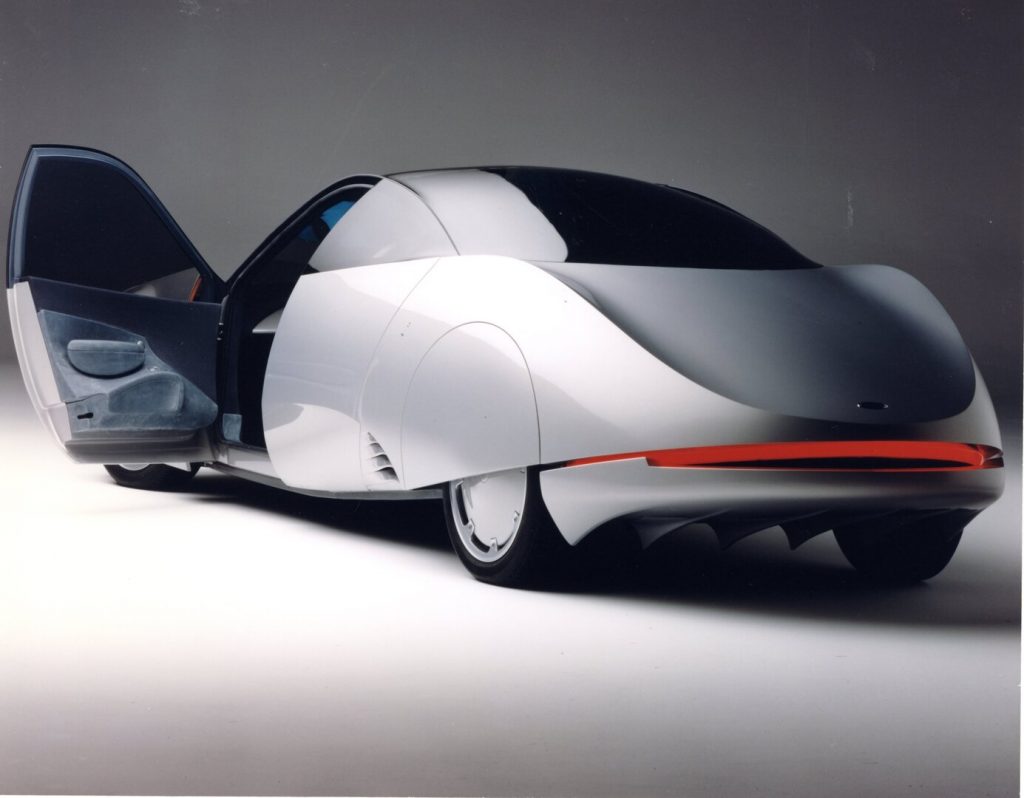
The car is also an extended range EV (EREV): a 1.0-liter rear-mounted gas engine powers a generator providing juice for four electric motors, one for each wheel. Fast forward to 2025, and EREVs are relatively niche stateside but very much a part of the electrified car landscape, especially in China. The Chevy Volt worked this way, as do the rotary (!) Mazda MX-30 R-EV, and certain examples of David’s BMW i3 if you opted for the range extender.
The upcoming Ramcharger, uh, Ram 1500 REV will be propelled by electric motors supported by a V6, while Honda’s two-motor hybrid powertrain employed in almost all its cars isn’t technically an EREV system, but works a lot like one—gas propulsion kicks in at highway speeds, but everywhere else, electricity gets you around and the engine is mainly a generator. Just off the top, though, the only real EREV to get four e-motors like the Synergy is China’s YangWang U8 luxury SUV.
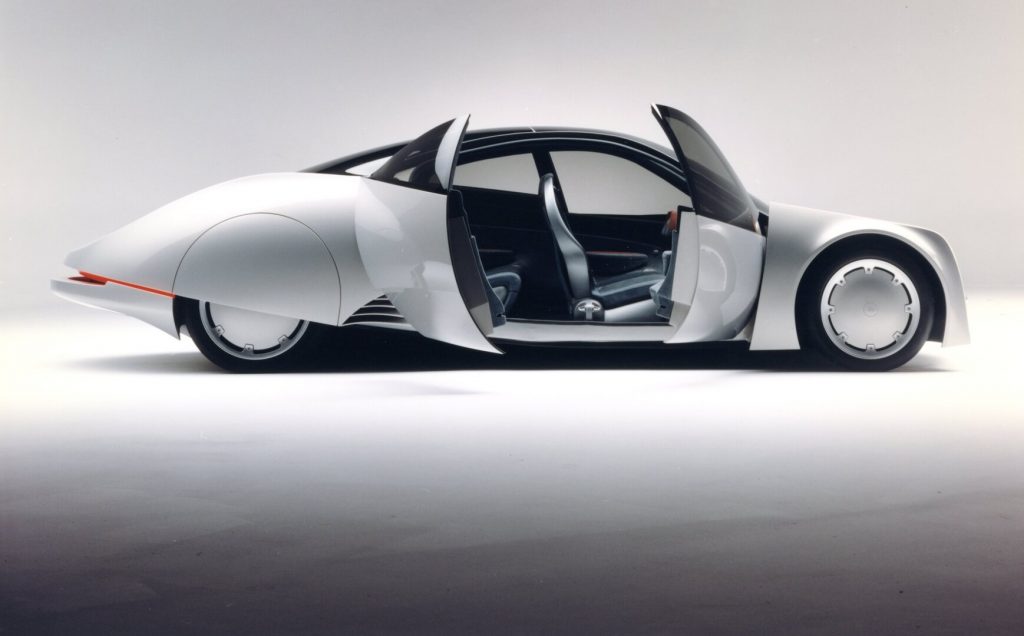
Ford’s 1996 concept also incorporated what we now know as regen braking, a technology that’s used in practically all EVs and hybrids: “Up front, a flywheel would collect excess engine and braking energy, which in turn would be released to augment the engine when, for example, the car needed to accelerate quickly or climb hills.”
The result of all this was said to be “theoretically triple” the fuel economy compared to the typical family sedan of the time. Looking back at official EPA figures, Ford fell short of tripling its fuel economy, but it did nearly double it in that time. The 1996 Ford Taurus got 21 mpg combined, while the 2010 Ford Fusion Hybrid scored 39. Ford spent the next 15 years working on EVs and sunsetting sedans, so those cars’ closest contemporary gas equivalent, the Escape Hybrid, still gets 39 mpg with AWD.
The Synergy 2010 also used cameras housed in the fin-style front fenders in lieu of wing mirrors, a real technology that’s used by many EVs today in jurisdictions that allow it (read: not North America).
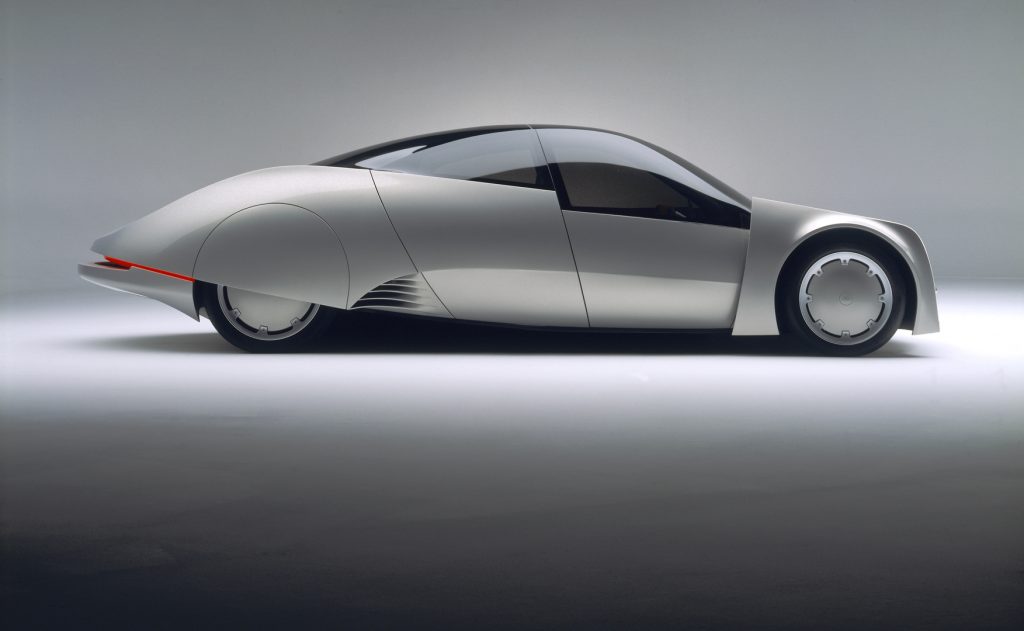
Those Formula 1-inspired fenders also contributed to a coefficient of drag of just 0.20, practically the same as slippery EVs like the Mercedes EQS, Tesla Model S, Lucid Air, and Xiaomi’s SU7. An all-glass roof (table stakes for many luxury cars these days) with solar cells powered a fan that removes hot air from the car when it was parked. Today, Tesla’s Cabin Overheat Protection function and timed interior ventilation in other EVs essentially do the same thing.
The Interior Isn’t Far Off From Cars Of The Day
The tech bits that Synergy 2010 predicted with straight-up eerie accuracy, however, were voice controls and the de-cluttering of automotive UI. From the release:
“To maximize spaciousness and minimize information overload, virtually all the electronic controls are voice-activated—resulting in an instrument panel totally devoid of switches, levers, or buttons The driver monitors vehicle basics by checking a heads-up display projected onto a glass card from a computerized “sourced image” at the back of the steering wheel. Here, colorful computer animation updates vehicle speed, tachometer, temperature and the like. Designers also demonstrate how this system could act as a futuristic video answering machine.

“A separate liquid crystal message center positioned in the middle of the instrument panel comes alive when voice-activated. Here, the driver can access features like an advanced navigation system, the entertainment system, climate controls—even the Yellow Pages. This message center is flanked by screens relaying video from the rearview cameras.”
I feel like I’m listening to someone from the Middle Ages describe Instagram with a time-traveler level of detail. Also, shoutout to the Yellow Pages, the default dinner table booster seat of the ’90s, and a privacy PR nightmare if it were introduced as a new idea today.
The Synergy 2010 even predicted modern-day EVs’ obsession with yokes. “The steering wheel design resembles an aircraft yoke, with the top and bottom thirds of the rim removed so that the driver has an unobscured view of the electronic displays as well as easier entry and egress.
“Also reminiscent of aircraft, the car’s steering column attaches to a cantilevered arm mounted in the center of the vehicle. This makes the vehicle easily adaptable for manufacture for either right- or left-hand drive markets.” OK, maybe that one was a bit of a reach. However, the Synergy’s driver seat is fixed, and it’s the pedals that move forward and back up to six inches. A similar setup would reappear in the 2017 Ford GT supercar.
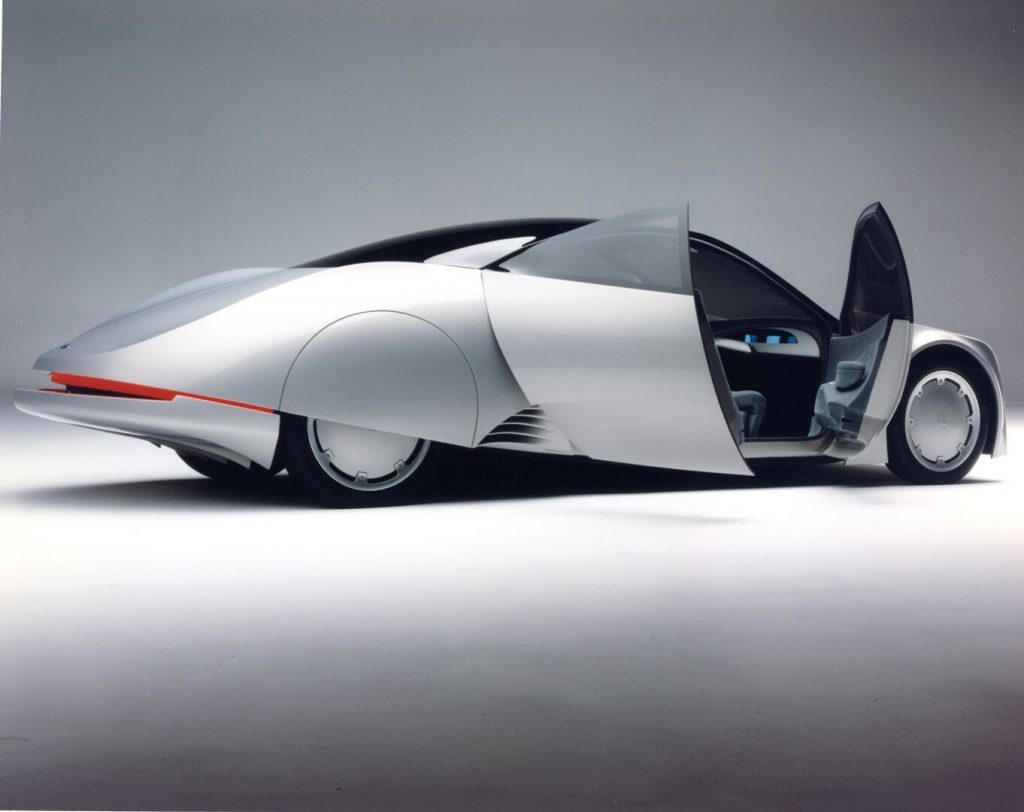
On a final style note, the concept’s French doors may not have caught on, but judging from the rear ends of what feels like every single new car today, the heckblende taillight bar absolutely has.
Hindsight is 20/20, and it frankly would’ve been unreasonable to expect a 1996 concept car called the Synergy 2010 to actually accurately resemble a production car we’d eventually get in 2010. And if I’m being honest, from a style standpoint, I’m not sure that was the worst outcome. The Synergy is striking to say the least, but is it attractive? I’m not so sure.
More importantly, however, it did get a bunch of technical details right about where the automobile was headed. It’s a wind tunnel-styled EREV with two big screens inside, a yoke, a glass roof, and one big taillight bar.
Perhaps Ford should’ve named it the Synergy 2021.
Topshot: Ford

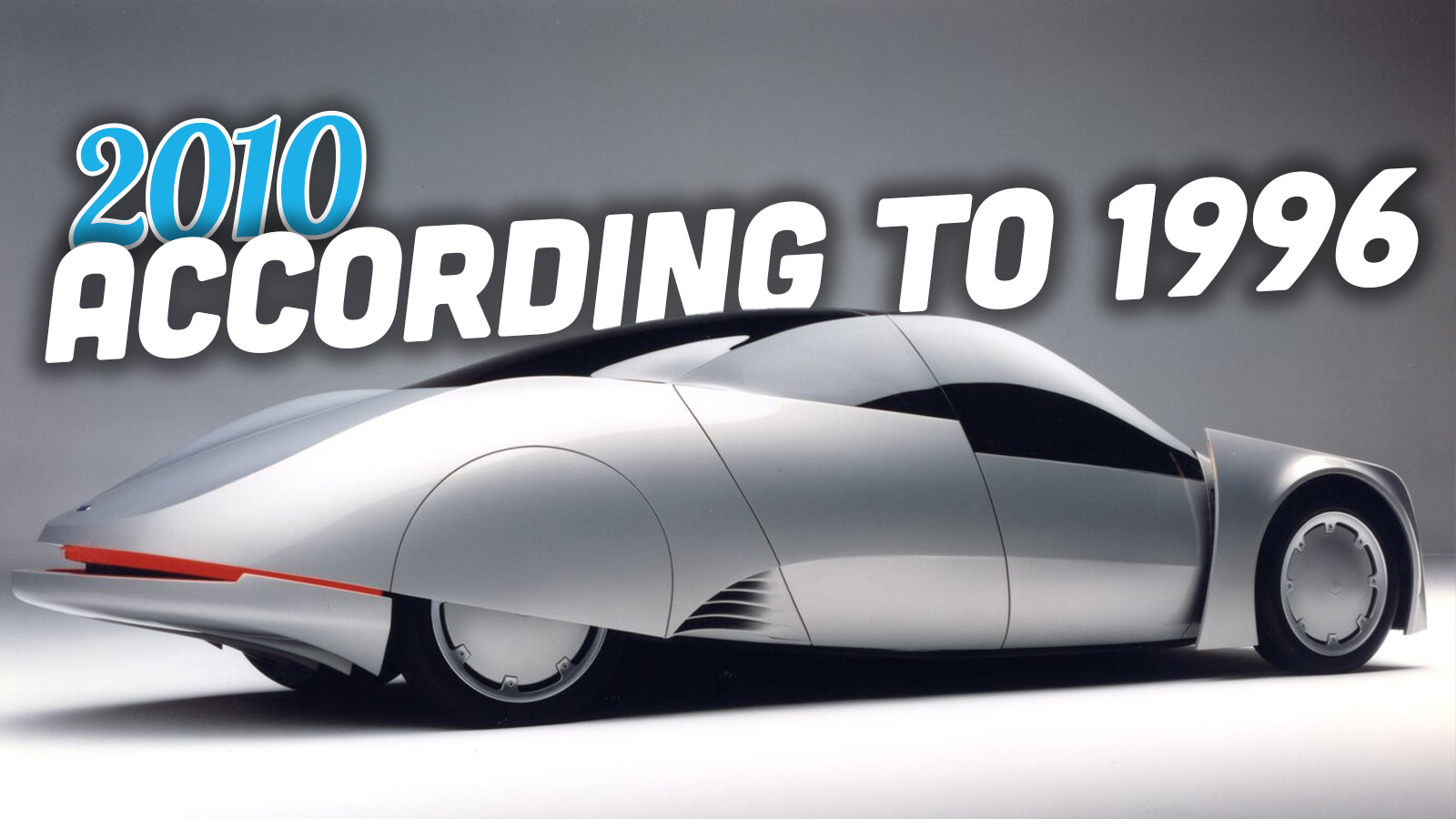






I remember this concept.
Also, 1996 being 30 years ago feels wrong.
I really like the rear end of I’m honest. It gives me retro futuristic vibes of a classis coupé. Everything else, no thank you.
I remember seeing this in magazines as a very little kid though.
Ah. There you go with the French (don’t call them suicide) Doors again.
The bodywork on this concept looks like it would have been a goldmine for collision repair places and their parts suppliers.
I wonder what Synergy 2039 will look like. (By which time, I will be 82. So, if I’m still here, I wonder what I will look like.)
I mean really we SHOULD all be driving cyberpunk 100mpg 1st gen Honda Insights, wheel covers and all, for the vast majority of the commuting population. Trucks/Vans should be taxed much higher to force more people into smaller cars. There’s zero reason people should be commuting in an F150 and never tow anything all year.
As I recall, in 1996 the internet was exploding into the mainstream, and techno futurists of the time imagined that having the world’s information at our fingertips would lead us to some kind of technological utopia. This car with its super aero and advanced technology feels very much like a product of that time.
If the people at Ford who created the design brief knew how we would *actually* end up using our newfound information technology, I wonder how different this car would have looked.
I remember energy-storing flywheels supposedly being the next great automotive innovation, but electric motor regen was already VERY much a thing in 1996, with escalators and locomotives having used it for nearly a century at that point. Why wouldn’t Ford have just said that? I’m assuming battery tech hadn’t matured enough at that point to allow for such rapid recharging? In 1996, NiCd would have been the rechargeable battery tech of the day, and those should be fully depleted prior to recharging, unlike lithium.
she thick in the back
It’s one of my favorite concept cars.
I think it’s interesting that the main mass of the body is shaped an awful lot like recent LMP cars. The front wheel wells are vertical and radiused blocks, with a narrower leading edge for the hood/frunk area, leading into a basically teardrop-shaped main cockpit and engine enclosure with diffuser aero at the rear. Make it a little wider, slap some wings on it, and slide the engine ahead of the rear axle, and you’d have a decent platform to start from, I bet.
Concept cars tend to omit the side-view mirrors, windshield wipers, turn signals and license plates. It looks sleek for that reason, and like a gussied-up Chrysler Concorde if you look carefully. Add the former items, a dealership logo and some bumper stickers, remove the front side wings and it would look much less like something from a comic book.
And let’s not even consider that interior…
Sedan not a sloped back crossover, so they were a bit off of they were shooting for the 2020s.
Surprised they didn’t get the SUV trend by that point with the growing popularity of the Explorer at that point. I get that it didn’t surpass cars until rather recently, but it was growing at a significant rate my mid/late 90s.
Yes for sure, they were also all body on frame suvs at that point. The then weird things like the Stanza wagon and cold vista wagon were not selling well.
I’d be shocked if these designers didn’t have the Hispano-Suiza Dubonnet Xenia on their inspiration board.
https://vintagenewsdaily.com/wp-content/uploads/2023/03/1938-hispano-suiza-h6b-dubonnet-xenia-4.jpeg
Weren’t the police cars from Demolition Man the closest we got to the current car design ethos? Very Tesla Model 3/Y ish.
Those were GM Ultralites. They weighed around 1,400 lbs, used a 111 horsepower 1.5L 3-cylinder engine, had a 0.19 drag coefficient, could accelerate from 0-60 mph in 7.5 seconds, and top out at 135 mph. They also got 88 mpg on the highway, 100 mpg at 55 mph.
I always find the different cycles in the industry fascinating to watch.
In the mid-to-late 80s and early 90s Ford had some great designs in production. With the success of the Taurus, the T-bird and Mustang, they were knocking it out of the park. But by the time the mid-to-late 90s came around, their products were looking long-in-the-tooth and this concept shows they were short on good idea.
From the mid-90s into the 00s, Dodge and Chrysler were the new design champs that the rest of the industry was looking at. Of course that title never seems to last long. 5 to 10 years seems to be the max that most companies can stay on top before their design language gets stale and someone else comes along.
Yea, and right now it’s Hyundai/Kia
Was.
I think they are on the downswing at this point.
Hyundai/Kia, and their Genesis brand isn’t bad either.
So an amalgamation of all of Kia’s current design language?
I get a kick out of how concepts always assume in the future, cars will never hit anything, so no need for bumpers. I appreciate the optimism.
They’ll drive themselves and never hit anything! It’s only a year or two away!
It’s kind of got that infinity j30 booty
These cars exist in Earth B, where Elio Motors is thriving and Tesla went under after its first year.
It’s out there at Lagrange 3. THEY just don’t want us to know.
Either that or it’s on the flip side of this flat Earth.
I tried to reach it once but hitting a teapot at 8km/sec will do a number on your windshield.
Was it the teapot with a painting of Benny Hill on it? Such a shame if that got smashed.
I had my music turned up and I didn’t hear the blue-shifted Yakety Sax before impact. I guess it’s on me.
Just as well, it doesn’t sound good sped up and in the wrong key.
It’s sort of like an Ioniq 6 with a ridiculous front end instead of a frunk.
The reason it looks nothing like most modern cars is that it’s a sedan-coupe instead of a crossover-coupe.
And weren’t we also promised nuclear powered flying cars too?
That outward visibility would be awesome
I think the extreme aero is actually an evolution of what Ford cars were doing, think of the Sierra concept cars and the oval Taurus and extrapolate. I’m not thrilled about screens and voice activation bit that’s not far off from modern EVs. Of course by 2010 the SUV and CUV were on the rise
I actually saw an oval Taurus wagon on the road this weekend, and for better or worse, its alien/space station look is still striking. Sure, it was a bridge too far, but wow did styling get more conservative afterward.
Yea, and weirdly those are starting to grow on me.
Pretty sure those doors are called chicken catchers.
I understood that reference 🙂
Sure, it looks like a SlapChop for pedestrians, but we could have had FINS, dammit!
Why cause suffering when you can insta-kill pedestrians?
On the other hand, it would be great in the oft-neglected sport of Drive By Deli Slicing.
That’s a good turn of phrase. Well done.
Then Ford created the Explorer, the Expedition, the Edge and totally Exterminated passenger cars. Their vehicles were part of the End of small hatchbacks and sedans. Now we all drive SUV/CUV crap in ovoid shapes that all weigh 3500-7500lbs for single occupants to get to work and *occasionally* carry passengers. While doing this, all of our generated user data is being sold off for corporate profit while we pay large monthly payments. The future isn’t what it was hacked up to be. I miss 1996.
Just think: one day you’re gonna say “I miss 2025.” Let that sink in.
That’s the most depressing thing I’ve read all week. Not really, but still…
We are living the memories we will one day remember.
But I think since 2015 or so we’re basically living the traumas were going to pay to treat.
That’s what a for-profit healthcare care system gets you.
Oh Fuck.
You know, there were definitely some years people are less nostalgic for than others. I’m hoping 2025 will only be “better times” as long as 1935 was.
Despite my initial comment, deep down I share your hope too.
I think nostalgia stops at 2019. Just as German Jews in 1942 wouldn’t be nostalgic for 1934.
Yeah….except there were plenty of German non-Jews who I’m sure remembered the time fondly, long after they should have (they shouldn’t have at the time but especially in like 1975…)
Nostalgia is one helluva drug.